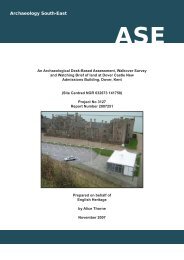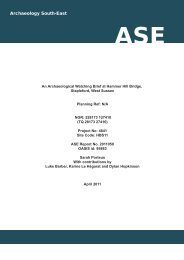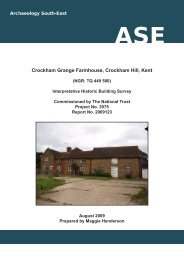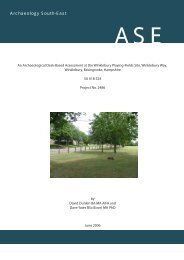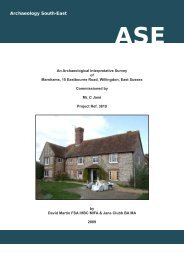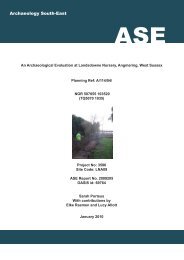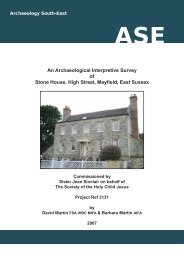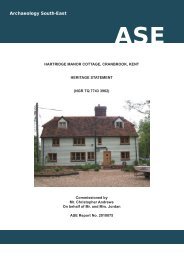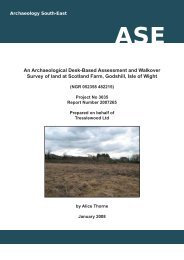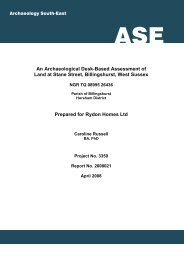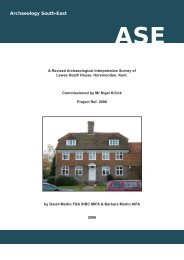ASE front cover - Archaeology South-East
ASE front cover - Archaeology South-East
ASE front cover - Archaeology South-East
Create successful ePaper yourself
Turn your PDF publications into a flip-book with our unique Google optimized e-Paper software.
<strong>Archaeology</strong> <strong>South</strong>-<strong>East</strong>2008058: Holbury Infants School, Holbury, Hampshireinclusions 10-40mm in size. A significant quantity of pottery, some 64sherds, probably dating to AD 320-350 though possibly slightly earlier butnot pre-dating AD 300, were re<strong>cover</strong>ed from [1016] along with brick, tegulaand fragments of burnt clay. Fill [1019] was a mid grey clay with moderategravel inclusions 10-20mm in size, which produced pottery dating to AD300-360 and brick and tegula. Fill [1017] was a dark grey clay withoccasional gravel inclusions 10-50mm in size and frequent flecks ofcharcoal. Pottery dated from AD 270 to the early/mid 4 th century, including atall beaker base possibly imitating a New Forest fineware form which postdates AD 300, was re<strong>cover</strong>ed from [1017] along with Roman brick andtegula, burnt clay with a flat surface and a possible fragment of quern stone.Fill [1031] was a mid brown silty clay with occasional gravel inclusions 10-50mm in size. Fill [1014] was a mid brown silty clay with occasional gravelinclusions 10mm in size, which produced pottery dated from AD 270 to theearly/mid 4 th century, Roman brick and tegula, burnt flint, stone and metal.Fill [1008] was a light orangey brown silty clay with moderate gravelinclusions 10-30mm in size, which also contained pottery dated from AD270 to the early/mid 4 th century, including a sherd of Oxfordshire red-slippedware which is likely to date to the 4 th century, brick, tegula, metal and burntclay with a possible wattle impression. Intrusive post-medieval peg tile wasalso re<strong>cover</strong>ed from [1008].4.6.9 A further 7 fills: [1115], [1116], [1117], [1118], [1119], [1120] and [1130]were identified from the auger sample (Figure 8). Fill [1115] was an orangeybrown grey silty clay with moderate small gravel inclusions. Fill [1116] wasan orangey brown clayey sand with moderate flecks of charcoal. Fill [1117]was a greyish brown sandy clay with moderate small stones. Fill [1118] wasreddish brown mottled with orangey brown clayey sand with moderategravel inclusions. Fill [1119] was a greyish orangey brown silty gravely sandwith frequent gravel inclusions. Fill [1120] was an orangey brown silty gravelwith frequent gravel inclusions. Fill [1130] was a reddish orangey browncoarse silty sand with occasional gravel inclusions.4.6.10 Pit [1010] was circular in plan. Pottery, dating from AD 270 to the early/mid4 th century, and CBM were re<strong>cover</strong>ed from the surface of fill [1011], whichwas a mid brown silty clay with occasional gravel inclusions.4.6.11 The three pits were all located in close proximity and it is likely that they werebroadly contemporary and dug for a similar purpose. The exact nature andfunction of the three pits is difficult to determine. The lower fills of [1004] and[1009] produced evidence of waterlogged material, particularly within thelowermost fills examined in the auger samples and preserved wood wasre<strong>cover</strong>ed from [1023] a lower fill examined by the hand excavation of [1009].Various interpretations have been considered, including that these pits wereconstructed as wells or shafts, although these are often much deeper thanthe auguring samples indicated. It is possible that they served as storage orrubbish pits or they could possibly relate to quarrying. Quarry pits tend to befairly amorphous however those recorded at Pudding Lane in London variedsignificantly. Further, they ranged in size measuring up to 12m in diameterbut some only measured 1.5m in diameter by 0.80m depth (Milne 1985). Asmentioned, a Roman road is thought to have passed through the southwestern corner of the school grounds, running from Applemore Hill at Purlieuto Lepe, to the west of Fawley (Saunders 1927). The course of the road isobscured at Holbury by the housing estate surrounding the school but the16© <strong>Archaeology</strong> <strong>South</strong>-<strong>East</strong>



